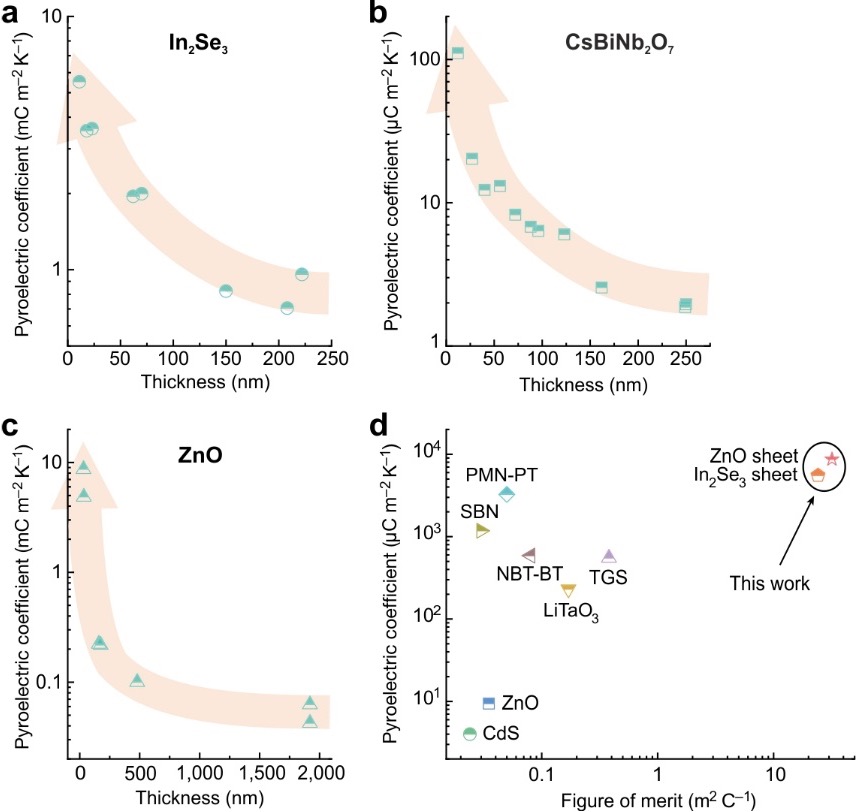PARADIM Highlight #63—External User Project (2022)
Jian Shi (Rensselaer Polytechnic Institute)
Pyroelectricity results in the generation of an electric voltage when the temperature of a material is changed. It occurs in materials with low symmetry and arises extremely quickly (on a picosecond time scale). It is widely used for thermal imaging, e.g., to spot people with a fever or poorly insulated regions of buildings, for night vision, or in motion detectors.

Figure: (a-c) Effective pyroelectric coefficients as a function of material thickness for In2Se3, CsBiNb2O7, and ZnO. Light orange arrows are guides for the eyes. d) Comparison of the pyroelectric coefficients and the figures of merit of In2Se3 (11 nm) and ZnO (32 nm) with those of conventional single-crystalline and epitaxial pyroelectric materials.
Various models have been developed to thoroughly describe the origins of pyroelectricity in bulk materials, but despite recent advances in materials simulation a conclusive answer for how this effect scales as pyroelectric materials become ultrathin remains largely unknown.
Here, researchers from RPI came to PARADIM to characterize three model pyroelectric materials whose bonding character varies from a van der Waals material (In2Se3), to a quasi-van der Waals material (CsBiNb2O7), to an ionic/covalent material (ZnO). Dimensionality affects all three materials, and an enhancement of the in-plane pyroelectric coefficient by factors of 10-100 is observed in thin sheets over thick ones, with ZnO showing the largest change (Figure c & d). The discovery opens a window to using ultrathin pyroelectrics to design and develop high-performance sensing and energy-conversion devices.
Pyroelectricity describes the generation of a polarization when the temperature of a material is changed. It only occurs in low symmetry materials, i.e., materials with polar point groups. When free-standing pyroelectric materials approach the 2D crystalline limit, the impact on pyroelectricity remained largely unknown. In this work, PARADIM users from RPI use three model pyroelectric materials whose bonding characters along the out-of-plane direction vary from van der Waals (In2Se3), quasi-van der Waals (CsBiNb2O7), to ionic/covalent (ZnO) and they experimentally show the dimensionality effect on pyroelectricity and the relation between lattice dynamics and pyroelectricity. They find, for all three materials, when the thickness of free-standing sheets becomes small, their in-plane pyroelectric coefficients increase rapidly. Furthermore, the material with chemical bonds along the out-of-plane direction exhibits the greatest dimensionality effect. The experimental observations evidence the possible influence of altered phonon dynamics in crystals with reduced thickness on their pyroelectricity. These findings should stimulate fundamental study on pyroelectricity in ultra-thin materials and inspire technological development for potential pyroelectric applications in thermal imaging and energy harvesting.
This study investigated the dimensionality effect on pyroelectricity in three types of materials (a van der Waals material In2Se3, a quasi-van der Waals CsBiNb2O7 and an ionic/covalent ZnO). A 10-to-100-fold enhancement of the in-plane pyroelectric coefficient was observed in the thin sheet over a thick one. Among the three materials, ZnO shows the greatest enhancement of more than two orders of magnitude. The measured pyroelectric coefficients and figures of merit in In2Se3 sheet of 11 nm and ZnO sheet of 32 nm are highest among all conventional single-crystalline and epitaxial pyroelectrics. The thickness-dependent lattice dynamics shown by molecular dynamics simulations, temperature-dependent Raman spectroscopy and synchrotron X-ray diffraction evidence the possible correlation between the electron–phonon renormalization and pyroelectricity. This discovery opens a window to using dimensionality-controlled pyroelectricity to design and develop high-performance sensing and energy-conversion devices.
PARADIM’s Electron Microscopy facilities enabled characterization of the materials.
J. Jiang, L. Zhang, C. Ming, H. Zhou, P. Bose, Y. Guo, Y. Hu, B. Wang, Z. Chen, R. Jia, S. Pendse, Y. Xiang, Y. Xia, Z. Lu, X. Wen, Y. Cai, C. Sun, G.-C. Wang, T.-M. Lu, D. Gall, Y.-Y. Sun, N. Koratkar, E. Fohtung, Y. Shi, and J. Shi, "Giant Pyroelectricity in Nanomembranes," Nature 607, 480–485 (2022).
This work is supported by the Air Force Office of Scientific Research under award number FA9550-18-1-0116, the US National Science Foundation under award numbers 1916652, 2031692 and 2024972, and the NYSTAR Focus Center at Rensselaer Polytechnic Institute under award number C180117. This paper is also supported by the U.S. National Science Foundation (Platform for the Accelerated Realization, Analysis, and Discovery of Interface Materials (PARADIM)) under Cooperative Agreement No. DMR-1539918 and made use of the Cornell Center for Materials Research (CCMR) Shared Facilities, which are supported through the NSF MRSEC Program (no. DMR-1719875). We thank J. Liu for the discussion on the mechanism of pyroelectricity. This research used resources of the Advanced Photon Source a US Department of Energy (DOE) Office of Science user facility operated for the DOE Office of Science by Argonne National Laboratory under contract DE-AC02-06CH11357.







